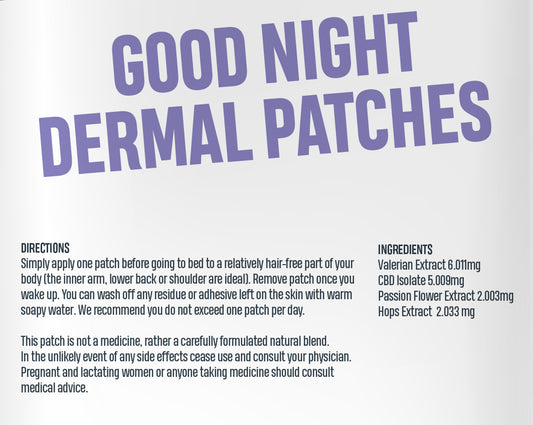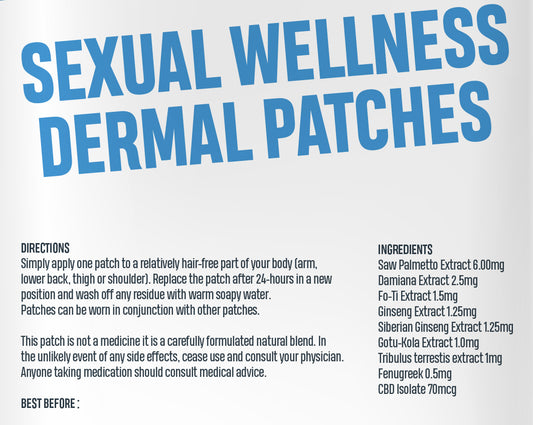What are Dermal Patches?
Dermal patches are a relatively new addition to the world of medicine, but they have already made a significant impact through their innovations in medicine and cosmetic and wellness industry. The first dermal patch was approved by the FDA as recently as 1979. Since then, there have been countless applications and use cases with the most common application today being the use for nicotine addiction (nicotine patches). More commercial patches have been developed to be used for pain relief, skin care, and even delivering vitamins.
So how do these patches work? Patches operate by releasing the medication into the bloodstream through the skin, through various biological and mechanical mechanisms allowing for consistent release and provide you with a long-lasting effect. Not only can you control how long you can feel the desired effect you can control the dosage. Patches can be created with a wide range of dose levels.
First impressions matter
Skin patches were not always seen in a positive light. In the early days of transdermal patches, there was a general lack of understanding and knowledge about how they worked and with this a high level of scepticism surrounded these products. At first only a few patches were available for public use, these being patches to help motion sickness and nicotine addiction. Doctors and the public had grown too used to oral medication so did not think much about the potential uses for the dermal patch.
Dermal Patches today
Since then, dermal patches have made leaps and bounds in their uses and applications. We are no longer limited to patches for only medical use. In recent years, there has been a growing interest in the use of dermal patches for cosmetic and wellness applications. For example, patches containing vitamins, minerals, and other nutrients can be used to deliver these substances through the skin and into the bloodstream and it doesn’t stop there!
While at the beginning there have been concerns and controversies surrounding dermal patches and their use, the development of new patches and the growing body of research supporting their effectiveness and safety. Today, dermal patches are widely accepted as a convenient and effective method for medical delivery, as well as for cosmetic and wellness applications.
Here at Patch Adam, we want to help deliver high quality CBD based products and also introduce you to more novel and exciting non-CBD based products using this technology. Have a look at our range of dermal products today!
Popular Dermal Patches
Here are a list of popular dermal patches currently being used and their benefits of use.
CBD Patches
These patches work by administering a consistent dose of CBD through the skin, allowing for a slow release over a period of time. This provides a sustained level of relief for users, making it an attractive option for those who want to manage their symptoms without the need for frequent dosing.
Nicotine Addiction
These patches contain nicotine and are designed to help smokers quit by reducing their cravings through a slow and steady release of nicotine. As a highly addictive substance, nicotine is notoriously difficult to stop consuming all together. Dermal patches are fantastic at releasing controlled amounts of a substance for your body to absorb.
This allows nicotine patches to be available in different strengths, gradually reducing users their nicotine intake over time until their body no longer becomes dependent on nicotine.
Motion Sickness
These patches are often preferred by patients who have difficulty swallowing pills or who are unable to tolerate injections. Motion sickness affects around 1 in 3 people. Lets also remember that many of those people will also not enjoy taking medication for it! So dermal patches are the perfect match for them.
Pain Relief
Many patients suffering from chronic pain find that dermal patches are an effective method of delivering pain relief medication. With patients who use dermal patches for pain relief often report experiencing fewer side effects than those who take medication orally. A great advantage over the common side effects of powerful ingested painkillers.
Nicotine Addiction
Dermal patches are also commonly used for nicotine replacement therapy. These patches contain nicotine and are designed to help smokers quit by reducing their cravings for cigarettes through a slow and steady release of nicotine. As a highly addictive substance, nicotine is notoriously difficult to stop consuming altogether. Dermal patches are fantastic at releasing controlled amounts of substance for your body to absorb.
This allows nicotine patches to be available in different strengths, gradually reducing users’ nicotine intake over time until their body no longer becomes dependent on nicotine.
Hormone Replacement Therapy
Another common use for dermal patches is hormone replacement therapy. Hormone replacement therapy is used to deliver hormones such as oestrogen and progesterone to women who are experiencing menopause where the patches help to alleviate symptoms such as hot flashes and night sweats. Some studies have found that dermal absorption of these hormones can actually be safer in some instances due to the lower dosage that needs to be applied when using skin patches compared to oral medication.
Treat Skin Conditions
Dermal patches can also be used to deliver medication to treat skin conditions such as psoriasis, eczema, and acne. The medication is absorbed directly into the skin, allowing for targeted treatment of the affected area. Patients who use dermal patches for skin conditions often find that they experience fewer side effects than those who take medication orally.
Allergies
Transdermal antihistamines. These are the local hormones that h
Dermal patches can also be used to deliver medication to treat allergies such as allergic rhinitis. These patches contain antihistamines, which are released slowly and steadily into the bloodstream through the skin. This method of medication delivery is particularly useful for patients who have difficulty swallowing pills or who experience side effects from oral antihistamines. Additionally, the patch provides a continuous release of the medication over a longer period of time, providing more sustained relief from allergy symptoms.
Hopefully, you are convinced of the effectiveness of dermal patches in a wide range of medical applications. They provide a safe, effective, and convenient method of medication delivery, and have helped many patients to manage their symptoms and improve their quality of life. As well as provide an effective method of delivery for cosmetic & wellness-based products.
Note that as the research continues into the potential uses of dermal patches, it is likely that they will play an increasingly important role in the treatment of various conditions and more applications will be discovered along the way.
How to apply a dermal patch
- Dry and clean the area where the patch will be applied. This is to ensure the patch has a good surface to stick on to
- Remove the backing from the patch to reveal the adhesive side
- Apply the patch to the prepared skin
- Press down firmly to make sure that the patch sticks
FAQs
How do dermal patches work?
Dermal patches work by releasing medication through the skin and into the bloodstream. The medication is absorbed into the skin through various mechanisms, such as passive diffusion and active transport.
Are there any side effects associated with dermal patches?
Like any medication, dermal patches can have side effects this depends on the patch that you take and the medication it is delivering. Please check the products for it’s common side effects and consult your doctor if that product is suitable for you.
However, on a side note many patients find that they experience fewer side effects with dermal patches than with their oral medication counterparts.
How long do dermal patches last?
The duration of a dermal patch varies depending on the medication and the dosage in the patch itself. Some patches may last for several hours, make sure you are applying the correct dosage for your intended use.
Are dermal patches safe?
Dermal patches are generally considered safe when used as directed. However, it is important to follow the instructions carefully and to discuss any concerns with your healthcare provider.
Can dermal patches be used for cosmetic purposes?
Yes, dermal patches can be used for cosmetic purposes. For example, patches containing vitamins and other nutrients can be used to deliver these substances through the skin and into the bloodstream.
Can dermal patches be used during pregnancy?
It depends on the medication being delivered and the specific patch. Some patches are safe to use during pregnancy, while others are not. It is important to discuss any concerns with your healthcare provider.
What is the difference between a transdermal and dermal patch?
Transdermal patches are a type of dermal patch that are designed to deliver medication through the skin and into the bloodstream. However, not all dermal patches are transdermal. Some dermal patches are designed to deliver medication directly to the skin, rather than into the bloodstream.
How often do I need to change my dermal patch?
The frequency with which you need to change your dermal patch depends on the specific patch and the medication it is delivering. Some patches need to be changed daily, while others can be worn for several days at a time. It is important to follow the instructions carefully and to consult with your healthcare provider if you have any questions or concerns.
Can I wear multiple dermal patches at the same time?
It is generally not recommended to wear multiple dermal patches at the same time, as this can increase the risk of side effects and drug interactions. If you need to use multiple medications at the same time, it is important to discuss this with your healthcare provider to determine the best course of action.
Can dermal patches be reused?
No, dermal patches are designed for single use only and should be discarded after use. Reusing a patch can increase the risk of infection and may not provide the intended level of medication delivery.
Can I shower or swim while wearing a dermal patch?
It depends on the specific patch and the medication it is delivering. It is advised you do not get the patches wet as this may interfere with the intended use. Some patches are designed to be water-resistant, while others are not. It is important to follow the instructions carefully and to consult with your healthcare provider if you have any questions or concerns about using the patch while showering or swimming.
Can I cut a dermal patch in half to adjust the dosage?
It is generally not recommended to cut a dermal patch in half, as this can affect the medication delivery and increase the risk of side effects. If you are unsure with the correct dosage for you to use talk with your healthcare provider.




